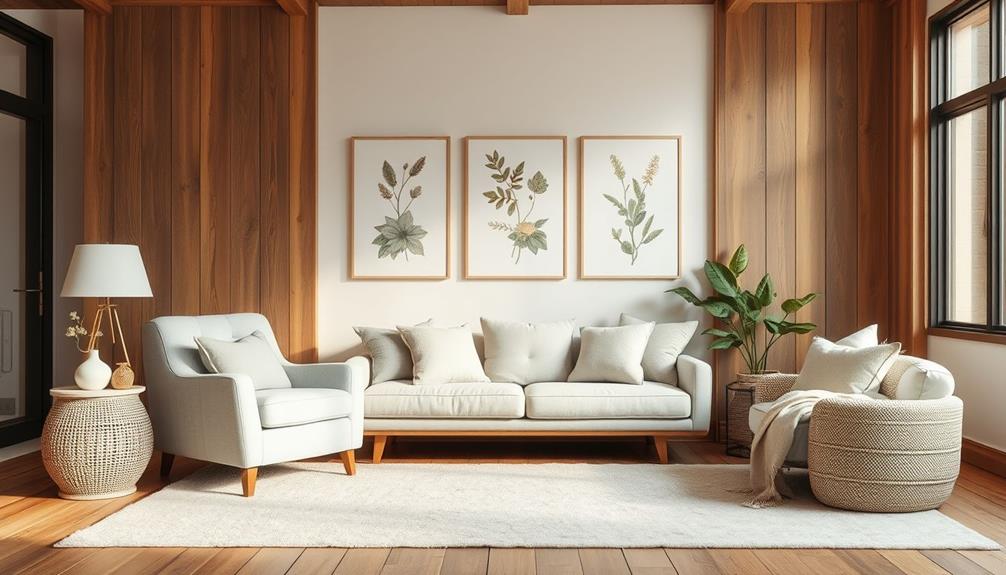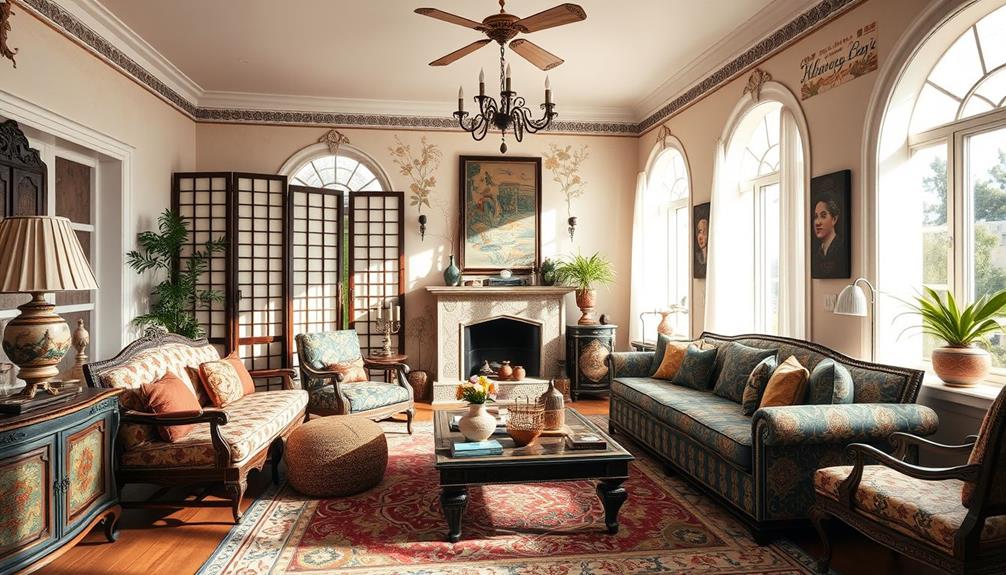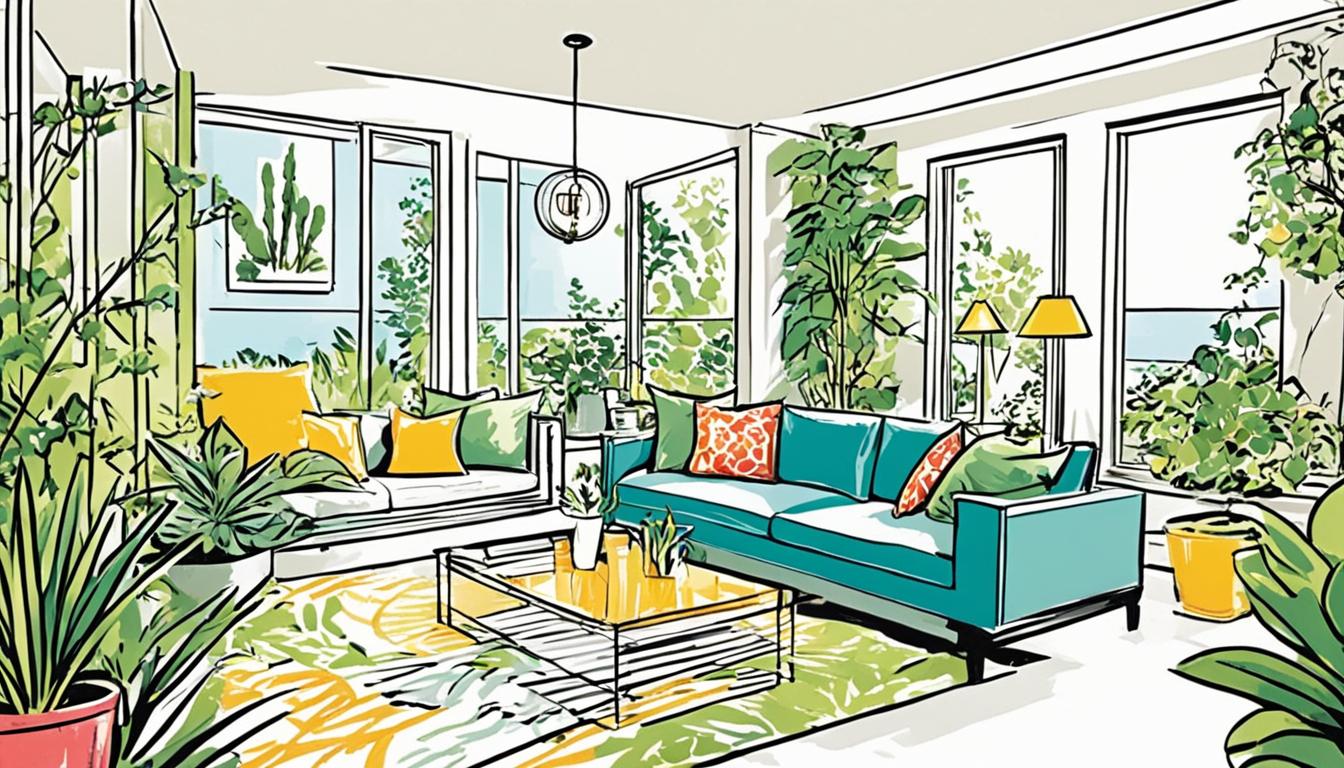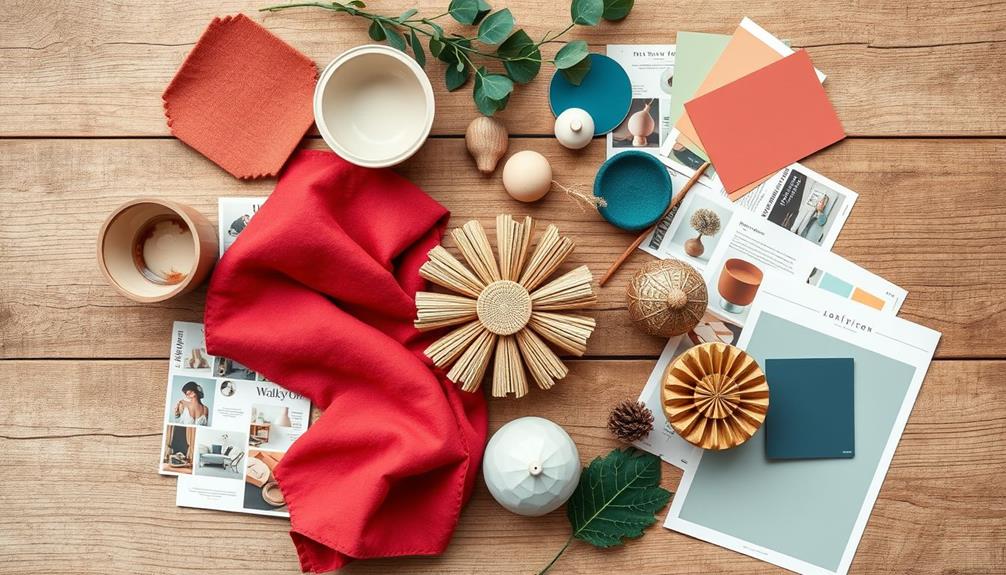To describe interior design styles, start by identifying their unique characteristics and elements. Modern design emphasizes clean lines and functionality, while traditional incorporates ornate details. You can explore styles like Bohemian for vibrant colors or Industrial for a raw, urban vibe. Consider the emotional ambiance—colors and textures affect how spaces feel. Mixing styles can create a personalized touch; for instance, combining modern elements with rustic pieces. Highlighting historical and cultural influences can also deepen your descriptions. If you want to uncover more tips and insights, continue exploring further!
Key Takeaways
- Identify and define specific design styles, such as Modern, Traditional, or Bohemian, to provide clear context.
- Highlight key characteristics, including color palettes, materials, and emotional qualities associated with each style.
- Incorporate historical and cultural influences to enrich the description of each style's significance.
- Encourage the blending of styles to create unique, personalized spaces that reflect individual tastes.
- Utilize resources like interactive quizzes and design blogs for inspiration and deeper understanding of various styles.
Understanding Interior Design Styles
Interior design styles often play an essential role in shaping the atmosphere of your living space. Understanding these styles can help you identify your tastes and make informed decisions when designing your interior.
Popular design options like Modern, Traditional, Bohemian, Industrial, and Coastal each bring unique elements, such as furniture, decor, and color schemes, that reflect personal preferences and cultural influences.
You might find yourself naturally gravitating towards an eclectic mix, combining elements from styles like Modern Farmhouse and Coastal. This blend can create personalized spaces that express who you are.
Familiarity with different design styles can also help you overcome common challenges, like merging inherited antiques with contemporary pieces or maneuvering overlapping preferences with family members.
Importance of Personal Style

Your personal style is the heartbeat of your home, shaping its character and ambiance. It reflects your design preferences and influences every aspect of interior design. By identifying your personal style, you can enhance your design experience, making it easier to choose colors, materials, and furnishings that resonate with you.
As you explore your tastes, you might find that your preferences evolve over time. Many people enjoy blending styles, creating unique environments that tell their story. Understanding your personal style helps you avoid design challenges, like mixing elements from different aesthetics, which can lead to confusion and an incohesive look.
To assist in discovering your design preferences, consider using interactive style quizzes and resources. These tools can guide you toward a clearer understanding of what truly resonates with you, allowing for a more informed and satisfying approach to interior design.
Embracing your personal style not only enhances the beauty of your home but also guarantees that it remains a true reflection of who you are. Ultimately, your space should be a canvas for your individuality, inviting warmth and comfort into your everyday life.
Key Characteristics of Styles

When you're exploring different interior design styles, it's crucial to understand their key characteristics. One of the first steps in understanding these styles is to familiarize yourself with the history and origins behind each one. For example, the mid-century modern style is characterized by clean lines, minimalism, and functionality, reflecting the design trends of the mid-20th century. On the other hand, the bohemian style is eclectic, colorful, and incorporates elements from various cultures.
To gain more insight into these styles and how to incorporate them into your own space, it’s helpful to seek out interior design blog tips. These online resources offer valuable advice and inspiration for creating a cohesive and stylish interior that reflects your personal taste and preferences. Whether you’re looking for ideas on how to mix and match different design elements or create a specific ambiance in a room, interior design blog tips can provide the guidance you need.
Each style has defining elements that influence its overall look, from the clean lines of Modern to the vibrant patterns of Bohemian.
Defining Style Elements
Five key characteristics define each interior design style, shaping its unique aesthetic and ambiance. When you're exploring popular interior design styles, pay attention to the key elements that set them apart. For example, modern design leans towards a neutral color palette with clean lines and minimal decor, while traditional design incorporates rich wood tones and ornate details.
Here's a quick comparison of some styles:
| Style | Key Elements | Color Palette |
|---|---|---|
| Modern Design | Clean lines, minimal decor | Neutral |
| Traditional Design | Ornate details, rich materials | Warm, rich tones |
| Scandinavian Design | Functionality, simplicity, coziness | Light, airy colors |
Transitional Interior Design balances modern and traditional elements, offering a versatile space. On the other hand, eclectic design thrives on vibrant colors and diverse textures, creating a layered look that reflects personal style. Scandinavian design prioritizes light colors and natural materials to evoke warmth. By recognizing these defining style elements, you can better articulate the essence of any interior space.
Common Design Influences
Across the spectrum of interior design, common influences shape the unique characteristics of each style. Each design approach brings its own essence, making it essential for you to understand these influences when crafting your space. For instance, the Modern Farmhouse style elegantly blends rustic charm with contemporary elements, often featuring key elements for farmhouse bedroom design like wrought iron beds and layered lighting.
- Modern Design: Emphasizes clean lines and a neutral color scheme, focusing on simplicity and functionality.
- Traditional Design: Characterized by rich wood tones and ornate details, it pulls inspiration from the 18th and 19th centuries.
- Bohemian Style: Features an eclectic mix of vibrant colors and layered textures, celebrating individuality and artistic expression.
- Industrial Style: Incorporates raw materials like exposed brick and metal, mirroring urban living with minimal decor.
You'll find that Mid-Century Modern combines clean lines and organic shapes, creating a seamless connection between indoor and outdoor spaces.
By recognizing these common design influences, you can better appreciate how each style reflects cultural and historical contexts.
Whether you lean towards the simplicity of modern design or the vibrancy of Bohemian style, understanding these characteristics will help you create spaces that resonate with your personal style.
Common Interior Design Styles

Exploring common interior design styles can transform your space and reflect your personality.
Start with modern design, which emphasizes clean lines and a neutral palette, focusing on simplicity and functionality. To enhance time management visually, consider incorporating stylish wall clocks that complement your decor.
If you prefer a more classic touch, traditional design showcases heritage elements with structured pieces, rich historical details, and ornate furnishings that create an elegant atmosphere.
For those who love a free-spirited vibe, the Boho style might be your go-to. This eclectic look embraces vibrant colors and diverse textures, often influenced by global cultures.
If you're drawn to a rugged, urban aesthetic, consider industrial style, characterized by raw materials like exposed brick and metal. It creates a masculine feel while maintaining a neutral color palette.
Lastly, if you want to evoke a serene beach atmosphere, coastal style is perfect. This style incorporates white-washed woods and shades of blue and white, enhancing your connection to nature.
Each of these styles offers unique elements, so choose what resonates with you to create a space that truly feels like home.
Blending Multiple Design Styles

Blending multiple design styles in your home allows you to create a space that's uniquely yours, reflecting your personal tastes and experiences. This approach can lead to personalized spaces that showcase your character while incorporating various cultural influences.
For instance, integrating elements from Mid-Century Modern Design can add a touch of nostalgia while still feeling contemporary. Popular combinations, like modern farmhouse with coastal elements or eclectic interior design, encourage creativity and can result in visually engaging interiors.
To successfully blend styles, consider these tips:
- Maintain a cohesive color palette to unify diverse elements.
- Balance contrasting pieces, ensuring harmony throughout the space.
- Incorporate both vintage pieces and contemporary pieces to enhance dynamic designs.
- Draw inspiration from your travels and cultural background for meaningful touches.
Emotional Ambiance in Design

Creating an emotional ambiance in design can greatly enhance your living space, influencing how you feel and interact with your environment.
Colors play a pivotal role, accounting for 60% of your emotional response. For instance, soft blues and greens can evoke tranquility, while vibrant reds and yellows can energize and uplift.
Textures are equally important; think about how soft textiles invite comfort in a bohemian setting or how sleek surfaces in minimalist designs project a sense of calm.
Natural elements, like wood and plants found in Scandinavian and rustic styles, connect you to nature, promoting a sense of well-being and serenity.
Lighting, too, shapes your emotional ambiance. Warm, layered lighting creates inviting atmospheres in transitional or traditional spaces, while harsh fluorescent lights can evoke feelings of sterility and discomfort.
Color Palettes and Textures

When you choose colors for your space, consider how they can affect your mood—soft blues might bring a sense of calm, while vibrant hues can energize a room.
Textural contrast also plays a key role; mixing smooth surfaces with cozy fabrics can add depth and interest to your design.
Color Psychology in Design
Colors wield incredible power in interior design, shaping the emotions and moods of a space. Understanding color psychology is essential for creating the desired atmosphere.
Warm colors like red, orange, and yellow can energize a room, making them perfect for social areas or creative spaces. For instance, incorporating vibrant accents can transform a neutral backdrop into a lively environment, enhancing the overall design aesthetic.
On the other hand, cool colors such as blue, green, and purple foster calmness, ideal for bedrooms or meditation zones. You can also explore cozy teenage girl room colors to find palettes that evoke comfort.
To achieve a harmonious design, consider these impactful strategies:
- Use neutral color palettes like whites, grays, and beiges as a versatile backdrop.
- Introduce vibrant accents to draw attention and add personality.
- Combine varied textures, like soft textiles or rugged surfaces, to enhance sensory experiences.
- Maintain balance in your room's aesthetic by mixing colors and textures thoughtfully.
Textural Contrast Techniques
Understanding how to manipulate textures can greatly enhance your interior design. By employing textural contrast techniques, you can create a dynamic environment that captivates the eye.
Start with a cohesive color palette that establishes a foundation for your design, and consider how yarn for scarves can inspire your choice of textiles regarding warmth and texture. Then, layer textures by combining materials like smooth leather with rough-hewn wood. This contrast not only adds visual interest but also depth to your space.
Incorporating textiles such as plush rugs alongside sleek furniture softens hard surfaces, adding warmth and comfort. Accessories play an essential role here; think woven baskets, metal accents, and soft cushions to enrich the sensory experience.
These decorative objects can also serve as focal points, drawing attention and inviting tactile exploration.
Don't forget about contrast hues within your color palette, as they can highlight different textures effectively. For instance, a bold accent color can make a textured wall art piece pop, enhancing its presence in the room.
Historical and Cultural Influences

Historical and cultural influences play an essential role in shaping interior design styles. Each era brings its unique context, reflecting the values, aesthetics, and technological advancements of its time.
For example, the grandeur of Victorian design emerged from the wealth generated during the Industrial Revolution. In contrast, the Arts and Crafts movement arose in the early 20th century, emphasizing handcrafted goods and simplicity as a reaction against mass production.
Mid-century modern design, influenced by post-World War II optimism, is characterized by clean lines and functionality, merging Japanese aesthetics with European modernism.
Mediterranean style merges Spanish, Italian, and French elements, highlighting outdoor living and the importance of natural light.
Asian Zen design promotes tranquility by incorporating principles of Feng Shui, utilizing natural materials and a minimalist aesthetic to achieve harmony and balance.
Here are a few key points to reflect upon:
- Historical design styles reflect their cultural and economic contexts.
- The Arts and Crafts movement prioritized handcrafted simplicity.
- Mid-century modern design showcases clean lines and functionality.
- Asian Zen design emphasizes tranquility through natural materials.
Understanding these influences can deepen your appreciation of various design styles.
Tips for Describing Styles

When you're describing interior design styles, using clear and specific terminology can make all the difference. Start by identifying the style you're discussing, like "modern interior design" or "rustic design." Highlight key features such as color palettes, materials, and furniture styles to create a vivid picture. Don't forget to include emotional qualities; for instance, rustic designs evoke a cozy, inviting atmosphere, while modern spaces may feel sleek and contemporary.
Here's a simple table to help you organize your thoughts:
| Style | Key Features | Color Palettes |
|---|---|---|
| Minimalist | Clean lines, simplicity | Neutral tones |
| Bohemian | Eclectic, vibrant decor | Bold, rich colors |
| Modern Farmhouse | Blending rustic and modern | Soft, muted shades |
Remember to incorporate historical context, like the mid-century modern movement, to enhance your description. Finally, encourage blending styles, as this can lead to unique and personalized interiors that reflect individual tastes. By using precise language and focusing on design elements, you'll convey the essence of each style effectively.
Resources for Discovering Styles

Exploring different interior design styles can be an exciting journey, and there are plenty of resources to help you along the way. Whether you're looking for a complete guide to popular styles or just some inspiring design ideas, you'll find a wealth of information at your fingertips.
- Interactive Quizzes: Discover your personal design style by answering fun questions about your preferences.
- Design Blogs & Websites: Browse curated galleries showcasing key elements of various styles, offering insights into home decor.
- Social Media Platforms: Use Pinterest and Instagram to explore and save images that resonate with your aesthetic.
- Books on Interior Design: Immerse yourself in literature that details different styles, their historical significance, and practical tips for implementation.
Additionally, community forums and design workshops can provide invaluable insights from fellow enthusiasts and professional interior designers.
These resources not only enhance your understanding of different interior design styles but also spark creativity, allowing you to transform your space into a reflection of your unique taste.
Embrace these tools, and let your design journey begin!
Conclusion
In understanding interior design styles, you embrace creativity, express individuality, and enhance your living space. By blending elements you love, you create a home that reflects who you are. Remember, it's not just about trends; it's about feeling at home. So, explore, experiment, and enjoy the journey of discovering your unique style. Whether you favor modern minimalism or rustic charm, your choices shape not only your space but also your experience of it.







